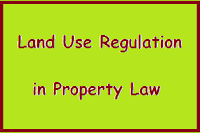Hello Reader, this time Tabir Hukum will discuss about land use regulation in property law.
The owner of a fee simple estate owns the most comprehensive bundle of rights in land that a person can own at common law or in equity, but the rights of the fee simple owner are not without limit. Zoning by-laws may limit what owners can do with their land through prohibiting some uses entirely, and segregating other uses, such as residential, industrial or commercial, into different geographic areas. Zoning by-laws can also segregate neighbourhoods by income level, by specifying that lots must be a minimum size and structures on them of a minimum value. Private covenants, may do the same thing.
Most Canadian jurisdictions also have a variety of statutes protecting distinctive environments or the habitats of rare or endangered species. Regulations made pursuant to these statutes may prohibit the landowner from stripping topsoil, draining wetlands, or even building on the property. Such regulation does not give landowners the right to claim compensation for expropriation, even though they may be unable to use their land as they wish, unless the regulation eliminates "virtually all of the aggregated incidents of ownership . . . having regard to the nature of the land and range of reasonable uses to which it has actually been put". (Mariner Real Estate Ltd. v. Nova Scotia (Attorney General), [1999] N.S.H. No. 283 (QL), para 49).
Some provinces also regulate access to land ownership, to achieve specific land use goals. Prince Edward Island sets an absolute ownership limit of 1,000 acres for individuals and 3,000 acres for corporations, with lower limits for non-residents wishing to acquire land on the coast. Some jurisdictions limit total ownership and non-resident ownership of agricultural land, and prohibit conversion of agricultural land to non-agricultural uses.
To facilitate private initiatives to preserve land from development and to protect species habitat and fragile or unique ecosystems, some provinces have created a new statutory form of property interest variously called conservation easements, covenants or servitudes. Generally, to create a conservation easement, a landowner signs an agreement with a government or non-governmental organization defining the permitted uses of a defined parcel of land. Once the agreement is registered in the appropriate registry or land titles office, it is enforceable by the other party to the agreement, and binds future purchasers of the land. The names used for these property interests suggest an analogy with the real property interests, but those interests can be created only to benefit neighbouring land, not other living organisms.
Umpteen posts of tabir hukum about land use regulation in property law, hopefully the writing of tabir hukum about land use regulation in property law can be beneficial.
Books : In Writing Tabir Hukum :
Alan M. Sinclair and Margaret E. McCallum, 2005. An Introduction to Real Property Law (Fifth Edition). LexisNexis : Canada.
 |
| Figure Property Law : Ownership, Title and The Limits of Ownership - Land Use Regulation in Property Law |


